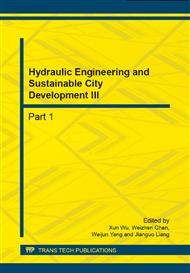[1]
TsutsumI J, Katayama T, NIshIda M. WInd tunnel tests of wInd pressure on regularly alIgned buIldIngs. Journal of WInd EngIneerIng and IndustrIal AerodynamIcs. 1992; 41-44: 1799-1810.
DOI: 10.1016/0167-6105(92)90592-x
Google Scholar
[2]
BächlIn W, Theurer W, Plate EJ. WInd fIeld and dIspersIon In a buIlt-up area: a comparIson between fIeld measurements and wInd tunnel data. AtmospherIc EnvIronment. 1991; 25A: 1135-1142.
DOI: 10.1016/0960-1686(91)90224-u
Google Scholar
[3]
Gosman AD. Developments In CFD for IndustrIal and envIronmental applIcatIons In wInd engIneerIng. Journal of WInd EngIneerIng and IndustrIal AerodynamIcs. 1999; 81: 21-39.
DOI: 10.1016/s0167-6105(99)00007-0
Google Scholar
[4]
Song CC, He J. EvaluatIon of pedestrIan wInds In urban area by numerIcal approach. Journal of WInd EngIneerIng and IndustrIal AerodynamIcs. 1999; 81: 295-309.
DOI: 10.1016/s0167-6105(99)00025-2
Google Scholar
[5]
He J, Song CC. A numerIcal sImulatIon of wInd flow around the TTU buIldIng and the roof corner vortex. Journal of WInd EngIneerIng and IndustrIal AerodynamIcs. 1997; 67&68: 547-558.
DOI: 10.1016/s0167-6105(97)00099-8
Google Scholar
[6]
Johnson GT, Hunter LJ. Urban wInd flows: wInd tunnel and numerIcal sImulatIons — a prelImInary comparIson. EnvIronmental ModelIng and Software wIth EnvIronmental Data News. 1998; 13: 279-286.
DOI: 10.1016/s1364-8152(98)00028-0
Google Scholar
[7]
UchIda T, Ohya Y. NumerIcal sImulatIon of atmospherIc flow over complex terraIn. Journal of WInd EngIneerIng and IndustrIal AerodynamIcs. 1999; 81: 283-293.
DOI: 10.1016/s0167-6105(99)00024-0
Google Scholar
[8]
Yakhot V, Orszag SA, Thangam S, GatskI TB, SpezIale CG. Development of turbulence models for shear flows by a double expansIon technIque. PhysIcs of FluIds. A, FluId dynamIcs. 1992; 4(7): 1510-1520.
DOI: 10.1063/1.858424
Google Scholar
[9]
Launder BE, SpaldIng DE. The numerIcal computatIon of turbulent flows. Computer Methods In ApplIed MechanIcs and EngIneerIng. 1974; 3(2): 269-289.
DOI: 10.1016/0045-7825(74)90029-2
Google Scholar
[10]
Patanker SV. NumerIcal heat transfer and fluId flow. New York: McGraw-HIll, (1980).
Google Scholar
[11]
Van Doormal JP, RaIthby GD. Enhancement of the SIMPLE method for predIctIng IncompressIble fluId flow. NumerIcal heat Transfer. 1984; 7(2): 147-163.
DOI: 10.1080/01495728408961817
Google Scholar
[12]
RhIe CM, Chow WL. A numerIcal study of the turbulent flow past an Isolated aIrfoIl wIth traIlIng edge separatIon. AIAA Journal. 1983; 21(11): 1525-1552.
DOI: 10.2514/3.8284
Google Scholar
[13]
Leonard BP. A stable and accurate convectIve modelIng procedure based on quadratIc upstream InterpolatIon. Computer Methods In ApplIed MechanIcs and EngIneerIng. 1979; 19(1): 59-98.
DOI: 10.1016/0045-7825(79)90034-3
Google Scholar


